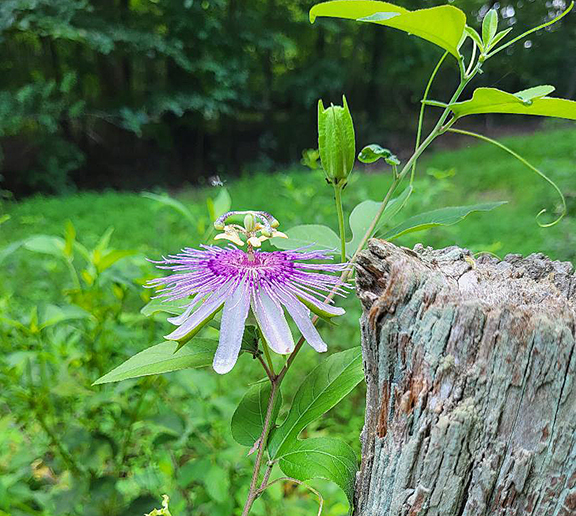Welcome!

Maypops or passion flowers are both lovely wildflowers and excellent additions to the home landscape. While you can transplant the wild ones you find, there are also plenty of hybridized versions of the plant available in many garden centers.
How to raise your own maypops
One of the pleasures of taking long walks for your health (even when you don’t want to) is the random pleasures you encounter along the way. You can walk by a spot for weeks, never noticing anything unusual and suddenly — there it is — a lovely maypop (Passiflora incarnata) growing up the pasture fence post.
How did it get there? Who knows? In all likelihood, a bird or a small mamma left a seed or two while taking a potty break. Oddly enough, deer aren’t particularly interested in maypops. They would rather nibble on your hostas or azaleas or euonymus or just about any other plant in your landscape. Some butterfly species are said to like the blossoms, too, but I hardly think a butterfly carried it in. I certainly don’t want to meet the one that did if that was the case.
As I may have mentioned in past garden articles, one of the chores my grandmother used to set my brothers and I to was pulling maypops out of the garden in late summer when the plant is most actively growing and setting fruit. As weeding chores go, that one wasn’t so bad. We spent quite a lot of time chucking maypop fruits at each other as we dodged among the tomato plants and bean vines.
I always thought that was where the plant got its common name. Maypop fruits do make a very satisfying “pop” when they land upside your brother’s head. But, according to one source, the name could be a corruption of the name “maracock” which is what the Powhatan and Algonquin Indians called it.
Its Latin name is a little easier to track down. European missionaries gave the plant the name passionflower and used its parts in the 1500s to help tell the Christian crucifixion story. The flower petals were said to represent the apostles. The prominent antlers stood for the five wounds of Christ and the filaments represented the crown of thorns.
Today, we tend to recognize the name as an herbal supplement that is supposed to be a good sleep aid and stress reducer. It ranks right up there with lavender for this particular use.
Because of its lovely flowers and late blooming season, passionflowers are a popular trellising plant for the home landscape. You can find plenty of varieties with flowers that range from white to dusty blue to various shades of purple. It is a deciduous plant, so take that into consideration as you determine where to place it.
Make sure, too, to give it full sun and loose, well-amended soil. Maypops may tolerate harder clay soils but that doesn’t mean they prefer to live there. Give it plenty of room to grow.. Once established, the vine can get to be 30 feet in length.
As for the one I discovered on my walk, I plan to leave it there. I’ll have to mark the site so that I don’t accidentally weed-eat it down. But, if I trellis it along the pasture fence, it should make a lovely addition to the driveway as summer winds down and we all start to dream of autumn.
